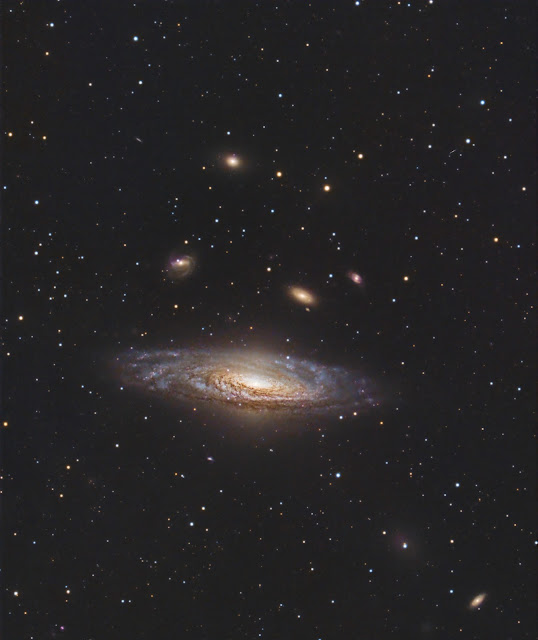NGC7331 and The Fleas ...
Monday October 7th was our club's imaging group, the Tuesday Night imagers, imaging session for the week at the club's observatory. I was unable to join in person as I had a work meeting, but joined via Zoom once my work meeting was over. The evening started out cloudy, so we worked on getting flats and worked on some processing in PixInsight. It cleared after 9 pm so we slewed the club's 14" Celestron Edge HD to NGC 7331 per a member's suggestion. We managed to collect 21 subs at 300 seconds each for 1.75 hours total exposure. This is my processing of the data.
 |
| NGC 7331, The Deerlick Group captured on 10/7 at the BMO |
Processing:
All pre and post processing was performed in PixInsight. Pre-Processing: All subs were visually inspected with Blink and subs with issues were removed. All light Frames, Flats, Darks and Dark flats were loaded into WBPP. Linear Post Processing: Background extraction was performed with Auto DBE Script from Seti Astro followed by BXT (correct only). SPCC was used for Color Calibration followed by a full application of BXT. The Stars were removed using StarXT. Starless Linear: Noise was reduced with NXT. The image was made non-linear with HT. Starless Non-linear Post Processing: HDRMultiScaleTransform was used to compress the core of NGC 7331 (mask was used). Saturation and intensity were increased with CT. LHE was applied at 3 Kernel sizes. Unsharp mask was applied and MMT was used to increase sharpness. Exponential Transformation was used to increase intensity. Stars Linear: The Stars image was made non-linear with Seti Astro's Star Stretch script. Stars Non-Linear: Saturation was increased with CT. Starless: Intensity, and contrast were adjusted with various applications of CT. The Stars and Starless images were combined with Pixel Math to produce the final image.
What is it?
The NGC 7331 Group is a "visual" grouping of galaxies in the constellation Pegasus. It is also known as the Deerlick Group. The large spiral galaxy is NGC 7331 and the four other galaxies that make up the group are NGC 7335, NGC 7336, NGC 7337, & NGC 7340. The four smaller galaxies are also referred to as The Fleas. NGC 7331 is a foreground galaxy; the Fleas are much farther away (see "How far is it?" below).
 |
| An annotated image of NGC 7331. |
How Big is it?
NGC 7331 has a size of 9.3 x 3.8 arcminutes (1 degree is 60 arcminutes) on the night sky. It is about 127,800 light years in diameter (similar in size to our Milky Way Galaxy).
NGC 7335 has an apparent size of 1.3 x 0.5 arcminutes and is about 113,000 light-years in diameter.
NGC 7336 has an apparent size of 0.6 x 0.5 arcminutes and is about 76,800 light-years in diameter.
NGC 7337 has an apparent size of 1.0 x 0.8 arcminutes and is about 95,400 light-years in diameter.
NGC 7340 has an apparent size of 0.9 x 0.6 arcminutes and is about 78,800 light-years in diameter.
How Far is it?
NGC 7331 is located about 47 million light-years (ly) from Earth.
NGC 7335 is located about 310 million light-years (ly) from Earth.
NGC 7336 is located about 430 million light-years (ly) from Earth.
NGC 7337 is located about 320 million light-years (ly) from Earth.
NGC 7340 is located about 310 million light-years (ly) from Earth.
How to find it?
The NGC 7331 Group is located in the constellation Pegasus as shown by the small red square in the Finder Chart below. Dark skies and large aperture are helpful in viewing this group.
 |
| A finder chart for NGC 7331 |
Image Details:



